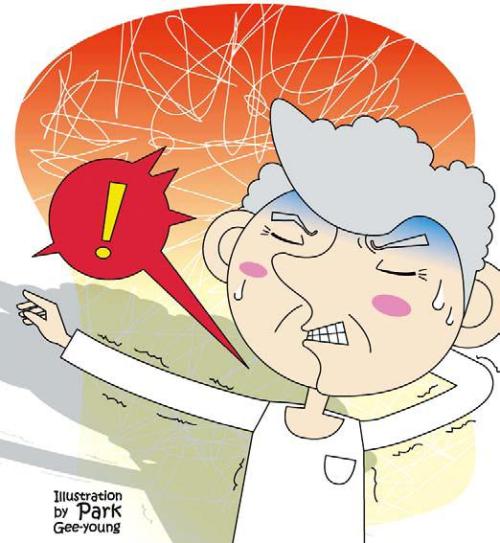A 65-year-old lady suffered walking difficulties for about five months. She visited five hospitals but was not diagnosed with any specific disease. Her symptoms only continued to get worse and finally she could not walk.

An MRI scan found that her spinal cord was squeezed by a narrow spinal canal and multiple disc herniation in the cervical spine. This is called cervical myelopathy.
Patients with cervical myelopathy here usually visit an oriental medicine doctor, neurologist or rehabilitation doctor because their common symptoms cause discomfort in using their hands, walking and/or balancing. They easily mistake it for a stroke. It is sometimes difficult even for doctors to make a correct diagnosis.
Cervical myelopathy results from spinal cord compression that may be caused by bony overgrowth, ligament ossification, or soft disc herniation. Meanwhile cervical radiculopathy is caused by the impingement on a nerve root, either narrowing of the neural foramen or a disc herniation.
Interestingly, a disc herniation or a bony protrusion can lead to both myelopathy or radiculopathy according to the direction of the herniation or protrusion. The area of dysfunction by compression is the most crucial difference between myelopathy and radiculopathy.
Generally it is not difficult to make a diagnosis for a patient with cervical radiculopathy, because the patient usually shows typical symptoms such as severe pain in an arm and/or forearm, difficulties moving their neck due to pain or the sudden contraction of a muscle, and muscle weakness.
The cervical myelopathy, however, usually starts with subtle symptoms such as tingling and numbness in hands or a sensation of heaviness in legs. And the symptoms of myelopathy are sometimes similar to those of ordinary cervical disc herination or low back disease such as radiating pain or weakness in upper or lower limb.
These subtle symptoms at first, or symptoms similar to those of cervical disc herination or low back disease, are the characteristics of cervical myelopathy and the key reasons why doctors sometimes make a wrong diagnosis.

Even though radiculopathy is a painful disease and sometimes seems very serious, it can be treated conservatively by medicine, physiotherapy or injection unless the patient has progressive motor weakness or intolerable pain. Few patients are considered candidates for surgical treatment.
However, the symptoms of myelopathy may not seem serious in the early stages but can develop severely. When a patient with cervical myelopathy shows typical symptoms and the symptoms get worse, the patient should receive surgery before the condition seriously deteriorates.
Cervical myelopathy is characterized by symptoms dramatically getting worse with intermittent stable periods or accelerating and functional declines accelerating. This natural history explains why a patient with deteriorating symptoms should receive surgical treatment as soon as possible.
It is a common belief that it is better to delay spine surgery. However, I have to say that it is not true for patients with cervical myelopathy. The earlier they receive the surgery, the more likely they can maintain their limb functions.
By Chung Sung-soo M.D., Ph.D.
The writer is director of orthopedic surgery at Samsung Medical Center. ― Ed.

An MRI scan found that her spinal cord was squeezed by a narrow spinal canal and multiple disc herniation in the cervical spine. This is called cervical myelopathy.
Patients with cervical myelopathy here usually visit an oriental medicine doctor, neurologist or rehabilitation doctor because their common symptoms cause discomfort in using their hands, walking and/or balancing. They easily mistake it for a stroke. It is sometimes difficult even for doctors to make a correct diagnosis.
Cervical myelopathy results from spinal cord compression that may be caused by bony overgrowth, ligament ossification, or soft disc herniation. Meanwhile cervical radiculopathy is caused by the impingement on a nerve root, either narrowing of the neural foramen or a disc herniation.
Interestingly, a disc herniation or a bony protrusion can lead to both myelopathy or radiculopathy according to the direction of the herniation or protrusion. The area of dysfunction by compression is the most crucial difference between myelopathy and radiculopathy.
Generally it is not difficult to make a diagnosis for a patient with cervical radiculopathy, because the patient usually shows typical symptoms such as severe pain in an arm and/or forearm, difficulties moving their neck due to pain or the sudden contraction of a muscle, and muscle weakness.
The cervical myelopathy, however, usually starts with subtle symptoms such as tingling and numbness in hands or a sensation of heaviness in legs. And the symptoms of myelopathy are sometimes similar to those of ordinary cervical disc herination or low back disease such as radiating pain or weakness in upper or lower limb.
These subtle symptoms at first, or symptoms similar to those of cervical disc herination or low back disease, are the characteristics of cervical myelopathy and the key reasons why doctors sometimes make a wrong diagnosis.

Even though radiculopathy is a painful disease and sometimes seems very serious, it can be treated conservatively by medicine, physiotherapy or injection unless the patient has progressive motor weakness or intolerable pain. Few patients are considered candidates for surgical treatment.
However, the symptoms of myelopathy may not seem serious in the early stages but can develop severely. When a patient with cervical myelopathy shows typical symptoms and the symptoms get worse, the patient should receive surgery before the condition seriously deteriorates.
Cervical myelopathy is characterized by symptoms dramatically getting worse with intermittent stable periods or accelerating and functional declines accelerating. This natural history explains why a patient with deteriorating symptoms should receive surgical treatment as soon as possible.
It is a common belief that it is better to delay spine surgery. However, I have to say that it is not true for patients with cervical myelopathy. The earlier they receive the surgery, the more likely they can maintain their limb functions.
By Chung Sung-soo M.D., Ph.D.
The writer is director of orthopedic surgery at Samsung Medical Center. ― Ed.



















![[Today’s K-pop] BTS pop-up event to come to Seoul](http://res.heraldm.com/phpwas/restmb_idxmake.php?idx=642&simg=/content/image/2024/04/17/20240417050734_0.jpg&u=)